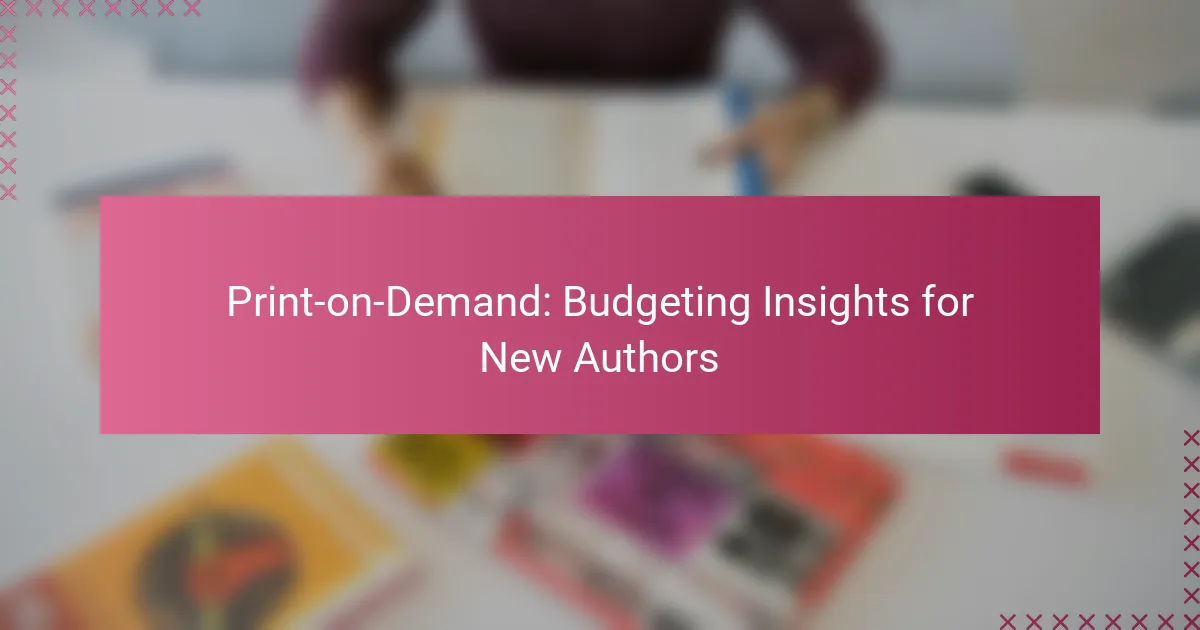For new authors venturing into print-on-demand publishing, effective budgeting is crucial to navigate the various costs and potential hidden fees. By estimating print volume and understanding the pricing models of platforms like Amazon KDP Print, IngramSpark, and Blurb, authors can create a financial plan that aligns with their publishing goals and maximizes their earnings.
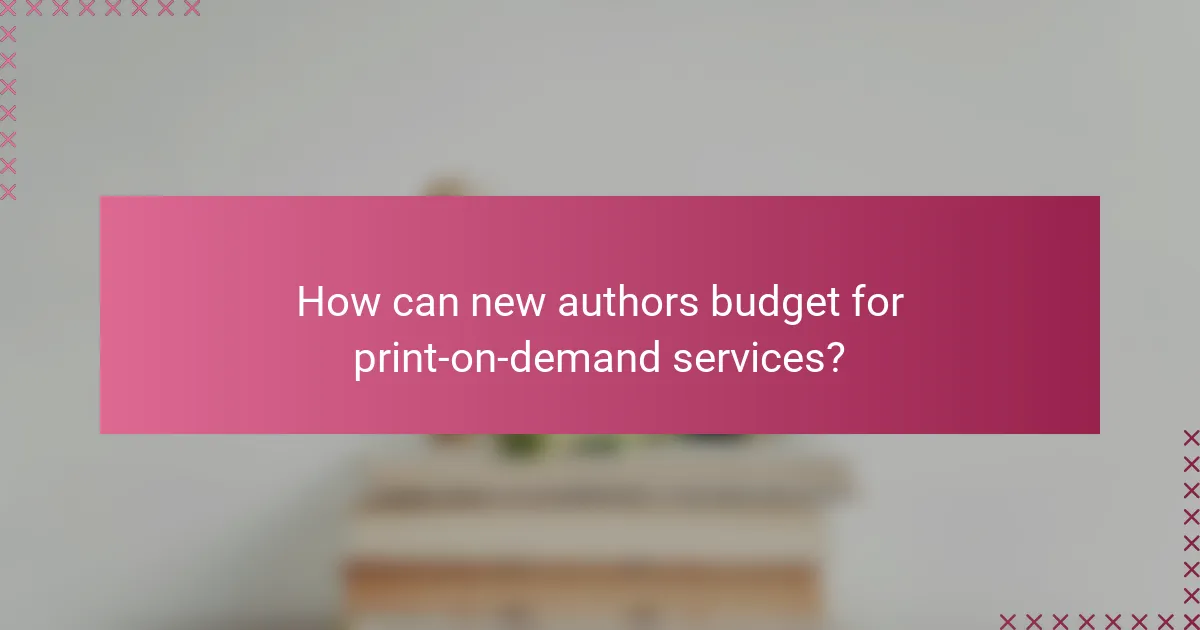
How can new authors budget for print-on-demand services?
New authors can effectively budget for print-on-demand services by understanding the various costs involved and planning for potential hidden fees. By estimating print volume and being aware of all associated expenses, authors can create a realistic financial plan that supports their publishing goals.
Understanding print-on-demand costs
Print-on-demand costs primarily include printing fees, shipping charges, and platform fees. Printing fees can vary based on factors such as page count, color options, and binding type. For example, black-and-white books may cost around $2 to $5 per copy, while full-color books can range from $5 to $15 or more.
Additionally, authors should consider the costs associated with distribution and royalties. Many print-on-demand platforms take a percentage of sales, which can significantly impact overall earnings. It’s essential to research different platforms to find one that aligns with your budget and needs.
Identifying hidden fees
Hidden fees can significantly affect your budget, so it’s crucial to identify them early. Common hidden costs include setup fees, file conversion charges, and additional shipping fees for returns or unsold inventory. Some platforms may also charge for premium services, such as expedited shipping or enhanced marketing options.
To avoid surprises, carefully read the terms and conditions of each print-on-demand service. Create a checklist of potential fees to ensure you account for all expenses when calculating your budget.
Estimating print volume
Estimating print volume is vital for budgeting effectively. Consider your target audience and marketing strategy to determine how many copies you might sell. For new authors, starting with a small print run of 50 to 100 copies can help manage costs while testing the market.
Keep in mind that print-on-demand allows for flexibility, enabling you to adjust your print volume based on demand. Monitor sales closely and be prepared to reorder as needed, which can help you avoid overproduction and unnecessary expenses.

What are the best print-on-demand platforms for authors?
The best print-on-demand platforms for authors include Amazon KDP Print, IngramSpark, and Blurb. Each platform offers unique features, pricing structures, and distribution options that can significantly impact an author’s budget and reach.
Amazon KDP Print
Amazon KDP Print is a popular choice for authors due to its seamless integration with Amazon’s marketplace. It allows authors to publish paperback books at no upfront cost, earning royalties of around 60% on sales after printing costs.
Authors should consider the limited options for trim sizes and paper types compared to other platforms. However, the ease of use and extensive reach make it a strong contender for new authors looking to enter the market quickly.
IngramSpark
IngramSpark is known for its wide distribution network, allowing authors to reach bookstores and libraries. While there is a small setup fee, authors benefit from a more extensive range of print options and higher quality printing.
It’s essential to factor in the additional costs for revisions and changes, as these can add up. Authors should also be aware that IngramSpark requires a more hands-on approach to formatting and uploading files compared to Amazon KDP Print.
Blurb
Blurb specializes in high-quality photo books, trade books, and magazines, making it ideal for authors with visually rich content. The platform offers a variety of print options and customization features, but authors should expect higher printing costs.
While Blurb provides tools for creating professional layouts, the pricing structure can be less favorable for authors looking to maximize profits. It’s advisable to calculate potential earnings carefully, especially if targeting a niche market.
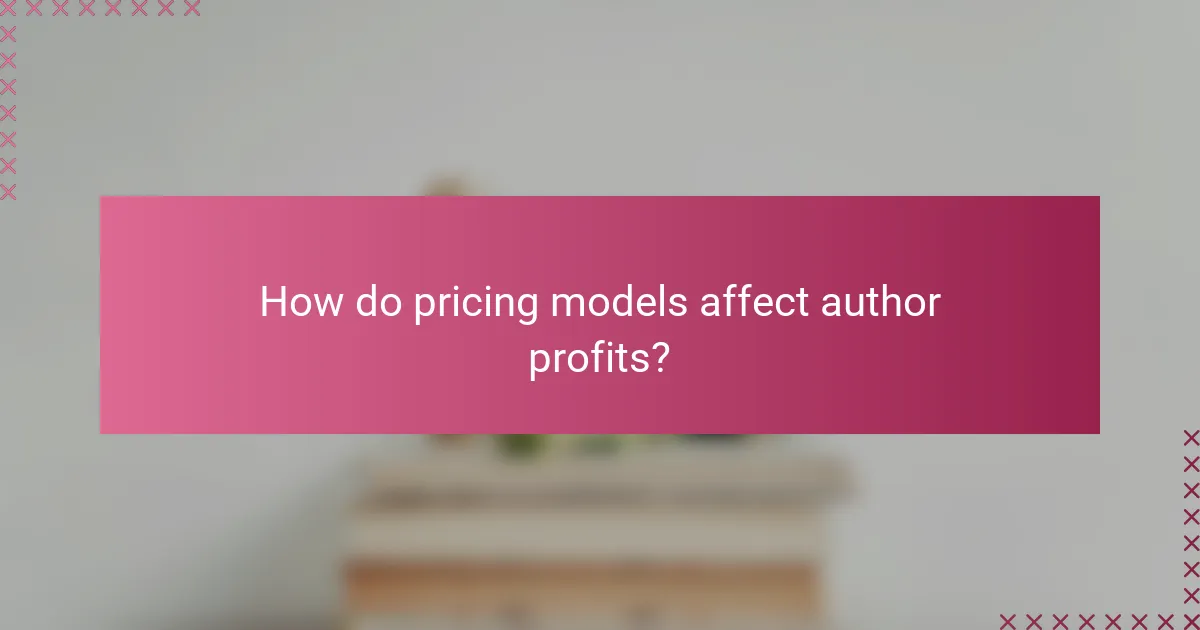
How do pricing models affect author profits?
Pricing models directly influence author profits by determining how much revenue an author earns per sale. Understanding these models helps authors make informed decisions about pricing their books and maximizing their earnings.
Royalty structures
Royalty structures vary significantly among print-on-demand services, impacting how much authors earn from each sale. Typically, authors receive a percentage of the sale price, which can range from around 30% to 70%, depending on the platform and pricing strategy.
For example, if a book sells for $20 and the royalty rate is 60%, the author earns $12 per sale. It’s crucial for authors to compare these rates across different platforms to find the most profitable option.
Cost per unit analysis
Cost per unit analysis involves evaluating the production costs associated with each book sold. Print-on-demand services often charge authors a base fee for printing, which can affect overall profitability. This fee typically ranges from a few dollars to around $10, depending on factors like page count and print quality.
Authors should calculate their break-even point by considering both the printing costs and the royalty percentage. For instance, if the printing cost is $5 and the author earns $12 per sale, they need to sell at least five copies to cover their costs before making a profit.
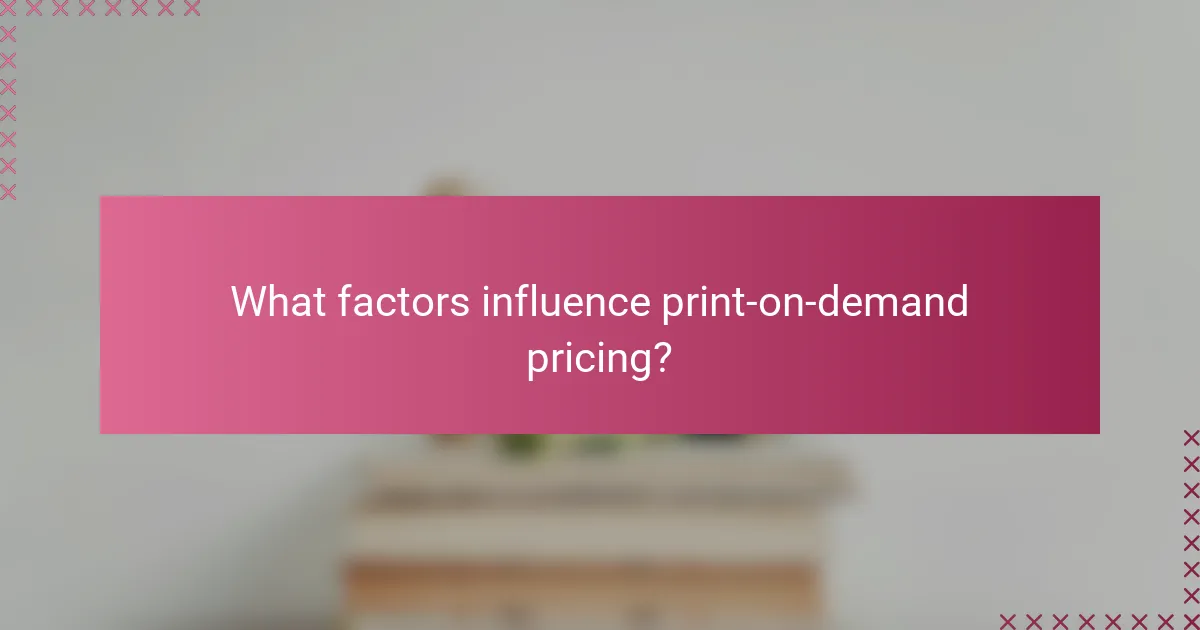
What factors influence print-on-demand pricing?
Print-on-demand pricing is influenced by several key factors, including book dimensions, format, and printing options. Understanding these elements can help authors budget effectively and make informed decisions about their publishing process.
Book dimensions and format
The dimensions and format of a book significantly impact its print-on-demand pricing. Common sizes include 5″x8″, 6″x9″, and 8.5″x11″, with larger formats typically costing more due to increased material usage. Additionally, choosing between paperback and hardcover formats can also affect the overall price, as hardcovers generally incur higher production costs.
When selecting dimensions, consider your target audience and genre. For instance, novels often use standard sizes like 6″x9″, while children’s books may benefit from larger dimensions for visual appeal. Always compare the costs associated with different formats and sizes to find the best balance between quality and budget.
Color vs. black-and-white printing
Choosing between color and black-and-white printing is another crucial factor that affects print-on-demand pricing. Color printing is more expensive due to the additional ink and processing required, making it ideal for projects like photo books or illustrated works. In contrast, black-and-white printing is more cost-effective and suitable for text-heavy books, such as novels or academic publications.
When deciding, evaluate the content of your book. If your book includes color images or graphics, weigh the benefits of color printing against the higher costs. For primarily text-based works, opting for black-and-white can significantly reduce your expenses while still delivering a quality product.

What are the shipping and fulfillment considerations?
Shipping and fulfillment are critical aspects for new authors using print-on-demand services. Understanding the costs and logistics involved can significantly impact your budget and customer satisfaction.
Shipping costs for different regions
Shipping costs vary widely depending on the destination. For example, domestic shipping within the United States typically ranges from $3 to $10, while international shipping can exceed $20, depending on the country.
When budgeting, consider using a shipping calculator provided by your print-on-demand service to estimate costs for various regions. This can help you set appropriate pricing for your books and avoid unexpected expenses.
Delivery times and customer expectations
Delivery times can affect customer satisfaction and repeat purchases. In the U.S., standard shipping usually takes 5 to 7 business days, whereas international orders may take two to four weeks or longer.
Communicate estimated delivery times clearly on your website and during the checkout process. Setting realistic expectations can help manage customer satisfaction and reduce inquiries about order status.

How can authors maximize their budget?
Authors can maximize their budget by carefully selecting print specifications and taking advantage of bulk order discounts. By making informed choices, new authors can reduce costs while maintaining quality, ultimately enhancing their profitability.
Choosing the right print specifications
Selecting the appropriate print specifications is crucial for managing costs effectively. Key factors include paper quality, book size, and binding type. For instance, opting for standard sizes like 6″x9″ can often be more economical than custom dimensions.
Consider the balance between quality and cost. While premium paper may enhance the book’s appeal, it can significantly increase production expenses. A good rule of thumb is to choose a paper weight between 50-80 lb for interior pages, which typically offers a balance of durability and affordability.
Leveraging bulk order discounts
Bulk order discounts can significantly lower the per-unit cost of printing. Many print-on-demand services offer tiered pricing, where the cost decreases as the quantity increases. For example, ordering 100 copies might reduce the price per book by 20-30% compared to ordering just 10.
When planning your budget, consider how many copies you realistically expect to sell. If you anticipate a strong demand, it may be worthwhile to invest in a larger print run. However, avoid overcommitting to large quantities that could lead to excess inventory and storage costs.
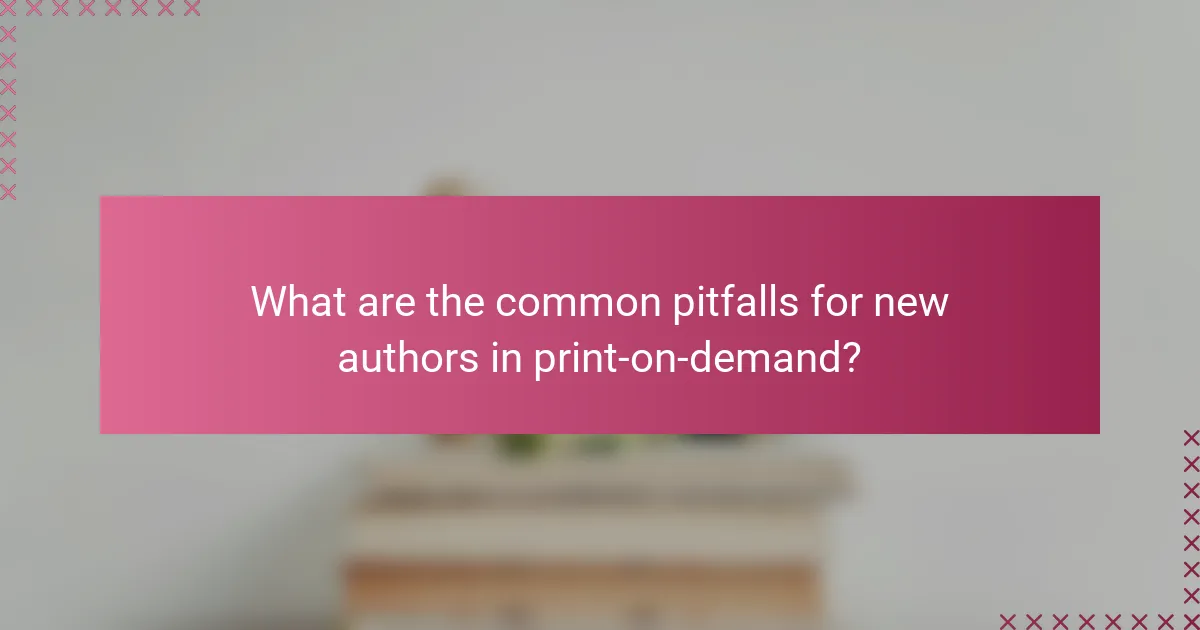
What are the common pitfalls for new authors in print-on-demand?
New authors in print-on-demand often face several pitfalls that can hinder their success. Key challenges include underestimating costs and neglecting essential market research, both of which can impact profitability and visibility.
Underestimating costs
Many new authors mistakenly believe that print-on-demand is a low-cost venture. However, expenses can accumulate quickly, including costs for cover design, editing, marketing, and platform fees. Authors should budget for these elements to avoid financial strain.
For instance, cover design can range from $100 to $500, while editing services may cost anywhere from $300 to $1,500 depending on the manuscript’s length and complexity. It’s crucial to account for these costs when planning your budget.
Ignoring market research
Failing to conduct thorough market research can lead to poor sales and wasted resources. Understanding your target audience and analyzing competitors can provide insights into pricing, genre trends, and effective marketing strategies.
New authors should explore platforms like Amazon to identify popular titles in their genre and assess reader reviews. This research can inform decisions on pricing, cover design, and promotional tactics, ultimately enhancing the chances of success in a competitive market.
